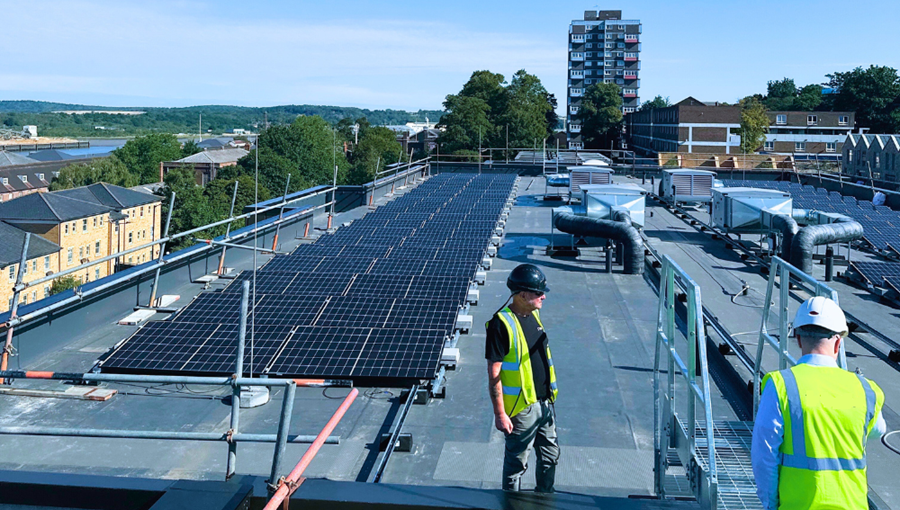CPD: New SAP 10.2 solar regulations for flats - What you need to know

The demand for energy efficiency in residential buildings, especially flats and apartments, is more pressing than ever. Architects, property developers, M&E consultants & engineers and build-to-rent (B2R) developers face challenges in balancing rising construction costs with compliance to increasingly stringent regulations.
Among these, Part L of the Building Regulations and SAP 10.2 play pivotal roles in defining how buildings must meet energy performance and carbon emission standards.
This article explores these challenges, the impact of Part L and SAP 10.2, and how innovative technologies can help overcome these hurdles.
The challenge: Navigating energy efficiency standards for flats
Architects and engineers working on apartment buildings must contend with complex design considerations while meeting regulations designed to reduce carbon emissions. With the introduction of updated standards, integrating renewable energy sources like solar PV has become essential, not just to achieve regulatory compliance, but also to enhance overall building performance.
- For architects: Energy efficiency must align with aesthetic and functional design.
- M&E consultants & engineers: Designing cost-effective systems that are also scalable is a core challenge.
- For property developers: Achieving high SAP scores at the lowest possible cost is vital for market competitiveness and regulatory approvals.
- For B2R developers: Compliance directly affects tenant satisfaction & retention and sustainability goals.
You can read more about solar for new-build flats here.
Part L
Part L of the Building Regulations in the UK focuses on Conservation of Fuel and Power, setting out requirements to ensure buildings are energy efficient and have a reduced environmental impact. It plays a crucial role in aligning construction practices with the UK's broader Net Zero Carbon goals by 2050.
The updated Part L regulations (effective from June 2022 in the UK) have introduced stricter requirements for energy efficiency and carbon emissions in buildings, with a clear emphasis on integrating renewable energy solutions like solar photovoltaic (PV) systems. Solar PV systems generate renewable electricity on-site, reducing reliance on grid energy and lowering carbon emissions. The updated Part L regulations acknowledge the role of solar PV as a practical, scalable, and cost-effective method to meet the tighter energy performance targets for both residential and non-residential buildings.
SAP 10.2
SAP (Standard Assessment Procedure) evaluates the energy performance of residential buildings. Introduced in 2022 in England and Wales, SAP 10.2 made a significant regulatory change: solar systems not directly connected to apartments no longer contribute to SAP scores or provide Energy Performance Certificate (EPC) uplifts.
This presents a challenge for apartment buildings where traditional solar PV systems are connected to common areas of apartment buildings only, which doesn't benefit residents. However, innovative solutions like Allume’s world-first Solar PV Sharing Technology (SolShare) ensure that apartments can fully utilise the benefits of solar power without this limitation.
The Solution - SolShare: Revolutionising solar PV integration in flats
Allume’s SolShare is transforming how solar PV integrates into flats or apartments. This technology offers a simple and cost-effective solution to connect solar power to flats while delivering significant benefits for the asset owners.
Unlike individual solar PV systems for each flat, SolShare provides a shared infrastructure that minimises installation and maintenance costs, making it a scalable solution for both retrofits and new builds.
Benefits of SolShare
Apartment buildings that incorporate renewable energy sources such as solar PV gain multiple advantages:- Tailorable solar allocation for flats: Even up the SAP scores in your building by giving each flat the required amount of solar energy (kWp) to achieve your building requirements.
- Increased SAP scores and EPC ratings: SolShare can improve SAP ratings by 5–15 points. This directly boosts EPC ratings, enhancing property values and making buildings more attractive to renters and buyers.
- Carbon emission reductions: Solar PV integration aligns with government-mandated carbon reduction goals, making projects more sustainable.
Learn more with our RIBA-accredited CPD seminar
Through Allume’s RIBA-accredited CPD course, professionals in architecture, property development, and electrical engineering services can gain a better understanding on how SolShare’s technology complies with new building regulations (Part L and SAP 10.2) for the energy performance of new and existing buildings.
This course is currently available until 31st January 2025. Get in touch to book your free session now.
By the end of this CPD, you’ll learn:
- How to identify apartment buildings that may benefit from a Solar PV Sharing Device.
- How to incorporate a Solar PV Sharing Device into your project.
- The benefits of solar power for flats: SAP boost, bill savings and reduced carbon footprint.
- How a Solar PV Sharing Device can generate ongoing revenue for the asset owner.